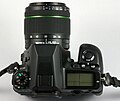Pentax K-7
Appearance
 | |
| Overview | |
|---|---|
| Type | digital single-lens reflex camera |
| Lens | |
| Lens | Interchangeable Pentax KAF3 and KAF2 mount compatible with Pentax auto-aperture lenses; older lenses supported in stop-down metering mode. |
| Sensor/medium | |
| Sensor | APS-C (1.54×) CMOS active pixel sensor with a primary color filter |
| Maximum resolution | 14.6 megapixels |
| Film speed | ISO Auto, 100, 200, 400, 800, 1600, 3200, boosted: 6400 |
| Recording medium | SD, SDHC; SDXC with firmware update 1.12 or later |
| Exposure/metering | |
| Exposure modes | Hyper Program, Hyper Manual, Sensitivity Priority, Shutter-Speed Priority, Aperture Priority, Shutter-Speed and Aperture Priority, Manual, Bulb, Green (Auto) |
| Exposure metering | TTL open-aperture metering with choice of: 77-segment, Center-weighted & Spot meter |
| Flash | |
| Flash | Onboard pop-up flash with high-speed sync, P-TTL external flashes via hotshoe, PC socket external flash, 1/180 s X-sync speed |
| Shutter | |
| Shutter speed range | 1/8000 s – 30 s, Bulb |
| Continuous shooting | 5.2 frames/s up to 40 JPEG images or 15 RAW images |
| Viewfinder | |
| Viewfinder | Eye-level pentaprism, near-100% coverage, 0.92× magnification |
| General | |
| LCD screen | 3″, 640×480 (VGA) |
| Battery | Rechargeable D-LI90 lithium-ion battery, optional AC adapter |
| Weight | 670 g (body only), 750 g (with battery) |
The Pentax K-7 is a 14.6-megapixel digital single-lens reflex camera, announced on 20 May 2009.[1] This is the first new flagship model released by Pentax since its merger with Hoya Corporation on 31 March 2008. It was discontinued late in 2010 in favour of the K-5.
Features
The Pentax K-7 was announced on 20 May 2009 and shipping began as of the first week of July 2009. The K-7 has the same pixel count as its predecessor, the K20D, but offers a significantly expanded feature set in a smaller body. New features include:[2][3]
- body is still weather resistant like the K20D; however, it is now made of magnesium alloy, and it is now also low temperature resistant
- a high-definition video recording function (30 frames per second at 1536×1024 resolution or HDTV (cropped))
- TAv exposure mode: Time/Aperture Value: photographer sets his own desired shutter speed/aperture, while the camera adjusts the ISO accordingly to compensate exposure
- in-camera high dynamic range imaging function to create one composite image from three images with different exposures
- dedicated AF-assist lamp
- in-camera electronic level that works with Earth's gravity, usable in total darkness too (a 1st by Pentax in any camera model from any brand)
- automatic horizon correction
- a new shutter rated for 100,000 actuations and capable of shutter speeds as fast as 1/8000 second
- continuous shooting speed of up to 5.2 frames per second
- a viewfinder with 100% field coverage
- a new Natural-Bright-Matte III focusing screen
- a new autofocus module
- a 77-segment light meter
- a newly developed DR II dust removal system
- a 3″ LCD monitor with a wide angle IPS panel with approximately 921k dots
- Face recognition in live view mode
- a new-generation Shake Reduction mechanism which can compensate for rotational movement
- lighter weight: the K-7 body weighs 55 g (7.5%) less than the K20D
- very quiet shutter[4]
References
- ^ Richard Butler (2009-05-20). "Pentax K-7 Hands-on Preview". DPReview. Retrieved 2009-05-20.
- ^ "Preview on dpreview.com".
- ^ "Official Pentax Imaging Web Site K-7 Highlights". Archived from the original on 2010-10-05. Retrieved 2010-08-31.
- ^ Mike Johnston (2009-05-20). "New Pentax Flagship, the K-7 (an early user review)". Retrieved 2009-05-20.
External links
- Official web page for the K-7 at PentaxImaging.com
-
back side with display
-
body with zoom lens
-
view from above
-
Pentax K7




